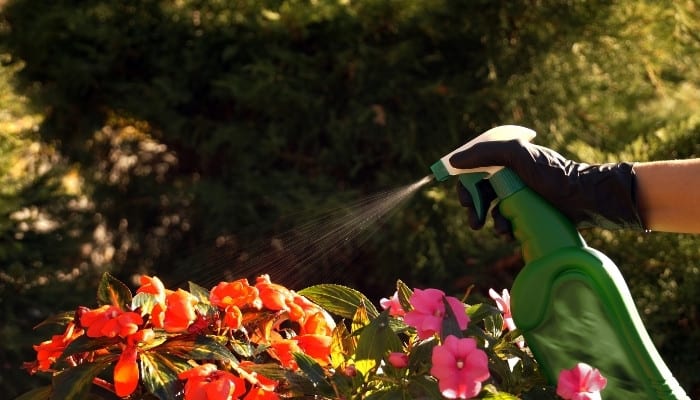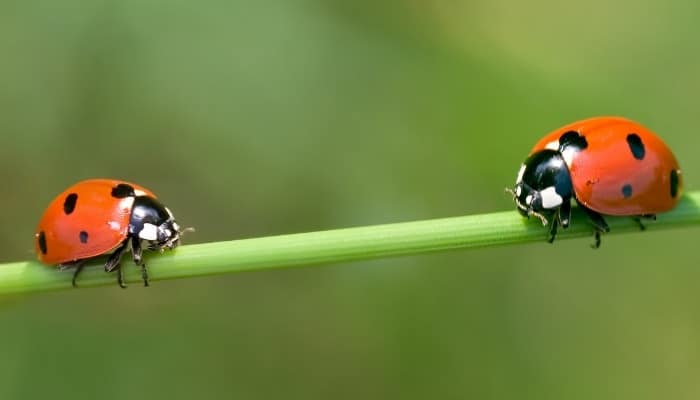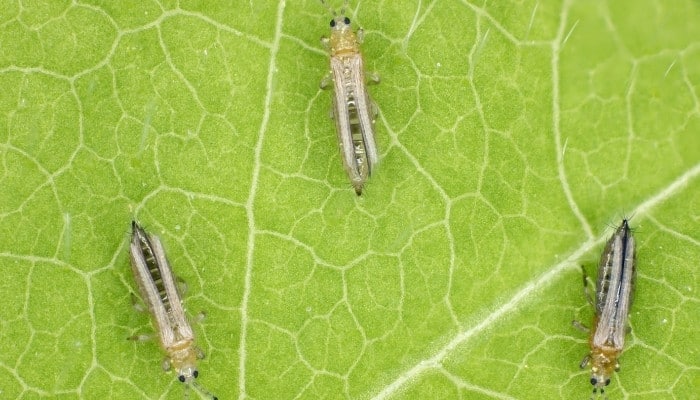Thrips, with their black-tinged wings, are tiny insects that have been extensively studied and documented, with over 6,000 known species.
Not only do thrips suck up nutrients from plants and damage them physically, but they are also a pest to humans and pets during warm summer days when they form swarms.
They aren’t poisonous or toxic, but they may cause skin irritation.
To check if thrips are infesting your plants, check the leaves, buds, and stems of your plants for tiny black specs.
You may need to use a magnifying glass in some cases in order to see the black specs left behind by the insects.
You can also hold a white sheet of paper under a branch of a plant you suspect is infected and tap the branch several times.
If a bunch of little black dots or winged insects end up on your paper, you have your answer.
If your plant has been damaged, whether it be on the stems, buds, foliage, or otherwise, the best course of action is pruning it first, regardless of the treatment method you choose.
That way the plant is not directing resources on damaged or dying parts, is encouraged to put forth new growth, and will be less desirable to pests such as thrips.
1. Spray Strong Blast of Water
Spraying strong blasts of water may not seem like a top-tier tactic for ridding your plants of thrips, but believe it or not, it really does do the trick.
That’s not to say it is an end-all solution, by any means, but it sure does knock those little buggers off!
2. Spray Soapy Water
The mere thought of soapy water sends most bugs running. Thrips are no exception. As soon as you hit them with a soapy blast of H2O, game over.
Tip: If you have hard water, use bottled distilled water when mixing your soapy solution.
3. Apply Neem Oil
Neem oil is truly a God-send when it comes to organic pest control, as it is a remedy against hundreds of harmful species of insects and bacteria.
Add a bit of neem oil to water, shake to mix, and spray it directly onto your plant’s leaves and stems with a spray bottle or mister. Be sure to hit the undersides of leaves as well.
This organic neem oil is what I use, and I always have great success.
4. Use Blue Sticky Traps
Blue sticky traps work in a similar fashion to the bug traps that keep cockroaches managed in climates with high humidity.
Once the insect steps onto the trap, that’s all she wrote. It’s game over; do not pass Go, do not collect $200, just sit on the blue sticky trap and wait to be thrown in the garbage.
Try this 24-pack of blue traps – you’ll love the cute designs!
5. Apply Diatomaceous Earth
Diatomaceous earth is another great form of organic pest control. It is easy to find locally or online and is also painless to apply.
Diatomaceous earth is best sprinkled around the bases of the plants and on the ground/area surrounding it. That way, as thrips are coming and going, they are killed before they can make it back to a plant.
To make application even easier, purchase a brand that comes with a powder duster, like this one.
6. Make an Essential Oil Spray

There are numerous types of essential oils that may work well as a spray-on form of pest control for ridding your plants of thrips.
The most recommended type of essential oil to use for thrips is orange essence oil (typically mixed with a bit of commercial bug soap or even dish liquid), though peppermint oil is often used as well.
Apply the solution to the plant via a spray bottle or mister.
This sweet orange essential oil smells amazing and comes with a handy dropper.
7. Mix Up a Spice Spray
After essential oils, spices are your next best bet for getting rid of thrips. Red pepper, paprika, garlic, and cayenne often work wonderfully.
The bad thing is, some species may be unaffected by it.
However, if you mix it in with, say, some diatomaceous earth or essential oil, you’d probably have an even better effect than using it alone. Spices may be sprinkled around and even on the plant.
8. Remove All Debris From Around Plants
Cleaning up the area around your plants is a common-sense approach to getting rid of thrips.
If you remove the debris from around your plants, the general area is less interesting to insects looking for their next patch of plants to devour.
Never underestimate the power of a clean working space!
9. Spray With Pyrethrin
Pyrethrin is a mixture of several organic compounds that are toxic to insects and can be sprayed onto plants like other pesticides.
When the insects encounter and ingest the compound, their nervous systems are more or less fried on the spot.
You can find it here on Amazon.
10. Apply Spinosad
Spinosad is another method for getting rid of thrips. In fact, it is thought to be more effective than most insecticidal soaps and oils on the market.
That said, if you use spinosad on your plants, it must not be applied more than one or two times per year. When applying it, mist or spray it onto the foliage.
Try this natural, pre-mixed solution that comes in a convenient spray bottle.
11. Attract Natural Predators

Natural predators are always an answer to pest-based problems. Introducing ladybugs or other natural predator bugs that will eat thrips to your plants is an organic method for ridding your plants of thrips.
As an added bonus, you’ll start to see other pest problems decline as well.
12. Vacuum Up Thrips
Vacuuming up thrips is really a thing, and it could really be the solution to your problem. If your thrip infestation hasn’t become a disaster, you may be able to simply suck them all up.
In combination with other solutions on our list, vacuuming may be the final step. At any rate, vacuuming up thrips is definitely a possibility.
13. Spray With a Kaolin Clay Mixture
Kaolin clay mixed into a liquid solution is another well-known natural solution for ridding your plants of thrips. It is best used in a sprayer or mister and directed onto the foliage of the plants.
Kaolin clay is a good pest control agent against thrips and mites while it won’t harm beneficial insects like ladybugs and honey bees.
This 2-pound pack will be plenty for treating current problems and more than enough for future outbreaks.
14. Use Light-Colored Mulch
Colored mulch, generally light blue or white, is often used as an alternative form of pest control. The light color confuses the bugs and hinders their ability to locate plants.
As an added step, once the pests are trapped in the mulch and away from the actual plants, predator insects may be released into the same area to decimate the thrip population.
15. Confuse Thrips With Aluminum Foil
Because aluminum foil bounces ultraviolet rays of sunlight back into the air, when placed around plants, insects change their course and avoid the confusing light.
An added benefit is that aluminum foil strips added to mulch also help retain moisture while reflecting more light up into the bottom of the plants.
16. Prune Regularly
Above all else, pruning your plants regularly helps avoid a thrip infestation to begin with. Additionally, pruning your plants that are damaged by thrips helps remove the pests as well.
Once a plant is damaged, thrips hang around and continue preying on the plant. That’s why it’s so important to prune damaged parts of plants regularly.
Which of These 16 Natural Solutions for Ridding Your Plants of Thrips is Best for You?
Ridding your plants of thrips naturally isn’t as hard as you may have previously believed, especially if you use a combination of techniques in your warfare.
Oftentimes, you’ll notice a drastic drop in the number of thrips bugging your plants in as little as a day or two after applying one of the natural solutions.
You can revisit this list as often as you need while you battle thrips and discover the best fix for you and your plants.

